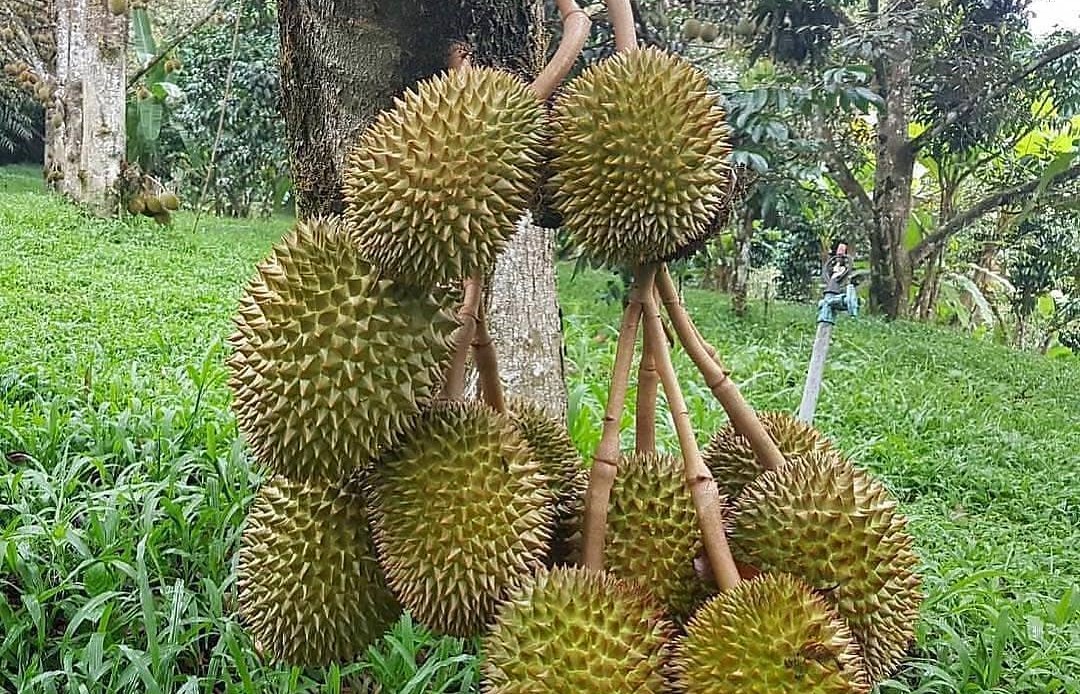
Naturally, durian tree take several years to mature and bear fruit. However, with the right cultivation techniques, it is possible to encourage early fruiting without relying on chemicals or excessive intervention. The key is to optimize the growth environment and leverage natural methods to enhance the fruiting process.
By applying these four natural methods selecting fast-fruiting varieties, using grafting techniques, employing stress techniques like stem injury, and optimizing sunlight and water farmers and gardeners can encourage durian trees to bear fruit earlier. These techniques not only save time but also ensure the healthy growth of the Durian Tree, resulting in a bountiful harvest of delicious durians.
4 Tips Make Your Durian Tree Produce Durian Fruit Early
Here are four tips to help your durian tree produce fruit early:
1. Choose the Right Genetic Variety
The genetic makeup of a durian tree plays a crucial role in determining how quickly it will bear fruit. Some varieties are genetically programmed to mature faster, known as “genjah” varieties. These early-bearing varieties can produce fruit in a shorter time compared to other types.
- Select genjah varieties: Look for durian varieties that are specifically bred for early fruiting. Genjah varieties, like genjah coconut, are an excellent example of plants that mature quickly. Choose superior varieties that have a proven track record of early fruit production.
- Seedling selection: Always choose high-quality, disease-free seedlings from reputable nurseries, as this gives your tree a head start on early growth and fruiting.
2. Utilize Grafting and Grafting Techniques
Another effective method to speed up durian fruiting is through vegetative propagation techniques such as grafting and grafting. These techniques allow you to clone branches or stems from a mature tree that is already fruiting, transferring its mature properties to the new tree.
- Grafting: This involves connecting a mature branch to the rootstock of another tree. Grafted branches tend to fruit earlier since they are already physiologically mature.
- Air layering and budding: These methods also encourage early fruit production by bypassing the slow seedling phase. By propagating trees vegetatively, even trees that are not genetically early-bearers can be made to fruit faster.
3. Induce Stress by Injuring the Stem
Injuring the stem of a durian tree is a technique used to encourage early flowering and fruiting. When a tree is injured, it triggers a defense mechanism that redistributes its energy from vegetative growth to reproductive processes, like flowering and fruiting.
- How to do it: Gently wound the bark of the main stem using a sharp tool. This disruption prevents the flow of nutrients to the roots, causing nutrients to accumulate in the upper part of the tree (stem, branches, and leaves), stimulating fruit production.
- Timing: Be cautious when using this technique—overdoing it can stress the tree too much, so make small incisions and monitor the tree’s response.
4. Optimize Lighting and Irrigation
Adequate sunlight and controlled water management are essential for the early fruiting of durian trees. Ensuring the tree receives proper lighting and irrigation can significantly influence the growth and flowering process.
- Lighting: Durian trees need abundant sunlight to thrive. If your durian tree is shaded by other plants or branches, trim away obstructions to allow more light to reach the tree. Direct sunlight helps speed up the tree’s metabolism, leading to earlier fruiting.
Water management: While durian trees need sufficient water in their early growth stages, reducing irrigation as the tree approaches flowering can help trigger fruiting. Controlled water stress encourages the tree to prioritize reproduction over vegetative growth, leading to quicker flowering a
Comments are closed